Harold Voyer (182cm/5’11”, 66kg/145lbs) is a PSG academy product, joining the club as a child before departing for Championnat National 2’s AS Poissy in the summer of 2017 — the same summer the centre-back had been linked with clubs such as then-EFL Championship sides Leeds United and Fulham, along with EPL side Newcastle United. You shouldn’t believe a lot of what’s reported in speculative mainstream football transfer media.
Voyer moved to Lens B for the 2019/20 campaign before departing Les Sang et Or for his current club, US Avranches, in the summer of 2020 — a move that saw the 25-year-old progress from National 2 to National 1, France’s third tier.
The PSG academy product has stood out as one of National 1’s most promising central defensive talents in a plethora of ways since moving into the third tier, as we’ll analyse in this tactical analysis piece, which is part four of our ongoing series looking into the most exciting talents in France’s Championnat National 1. Read part 1 (Florent Da Silva at Villefranche 2021/22: The teenager described as one of Lyon’s ‘biggest talents’ – scout report), part 2 (Godson Kyeremeh at Annecy 2021/22: National 1 promotion contenders’ 21-year-old MVP – scout report) and part 3 (Ahmad Allee 2021/22 scout report – National 1’s very own Andrea Pirlo?) here at Total Football Analysis!
The young left-footed centre-back recently did an interview with PSG-focused website Les Titis du PSG, which I’d recommend as a prelude to this article, in which he discussed his time in Paris as well as his time at Avranches thus far. The defender showed maturity and self-awareness when discussing his game, saying: “I joined this club in 2020. We play in National 1. I’m pretty happy with my season. I feel like I’ve crossed a line. Of course, I still have work to do, but I’m on the right track” and in this tactical analysis piece, we’ll look into Voyer’s individual qualities and role within Frédéric Reculeau’s Avranches strategy and tactics to give more context to these comments and really dissect the 25-year-old’s game to show what makes him one of National 1’s most intriguing players, where he can still improve and theorise what tactical role may succeed in getting the absolute best out of this talent.
Progressive passing ability
The most impressive parts of Voyer’s game are undoubtedly his on-the-ball qualities. The left-sided centre-back possesses fantastic technical ability which heavily exceeds the average in National 1 and belongs at a higher level. In terms of his on-the-ball performance, Voyer typically operates as a left centre-back in Avranches’ 4-2-3-1/4-3-3 system and the team often moves upfield through him, relying on his ball progression abilities to break lines and advance Avranches to more threatening areas.
This season, the 25-year-old has made 10.95 progressive passes per 90 — very high when compared with the rest of National 1’s centre-backs who have played at least 600 minutes this term (the criteria I’ve used to compare Voyer with his peers via Wyscout for all statistics mentioned in this scout report) — and while Voyer has made the most passes this season of any centre-back included in this set (60.55 per 90) with a decent success rate of 86.53%, he’s also made the second-most forward passes (28.77 per 90) of any centre-back in National 1 who meets the aforementioned criteria, highlighting his tendency to constantly get his head up and look for ways to move the team forward as opposed to playing it safer and not taking the risks involved with being the one to break lines and progress the team upfield.
Voyer doesn’t have the greatest progressive pass success rate or forward pass success rate in National 1 this term but considering how frequently he attempts such risky passes, that shouldn’t come as a major surprise either. Ultimately, Avranches are looking for someone to play the role of ball-playing centre-back and Voyer possesses the quality to perform this role to a relatively high level at the standard of France’s third tier, hence why he’s been entrusted with the ball progression responsibility a lot in Frédéric Reculeau’s team this season.
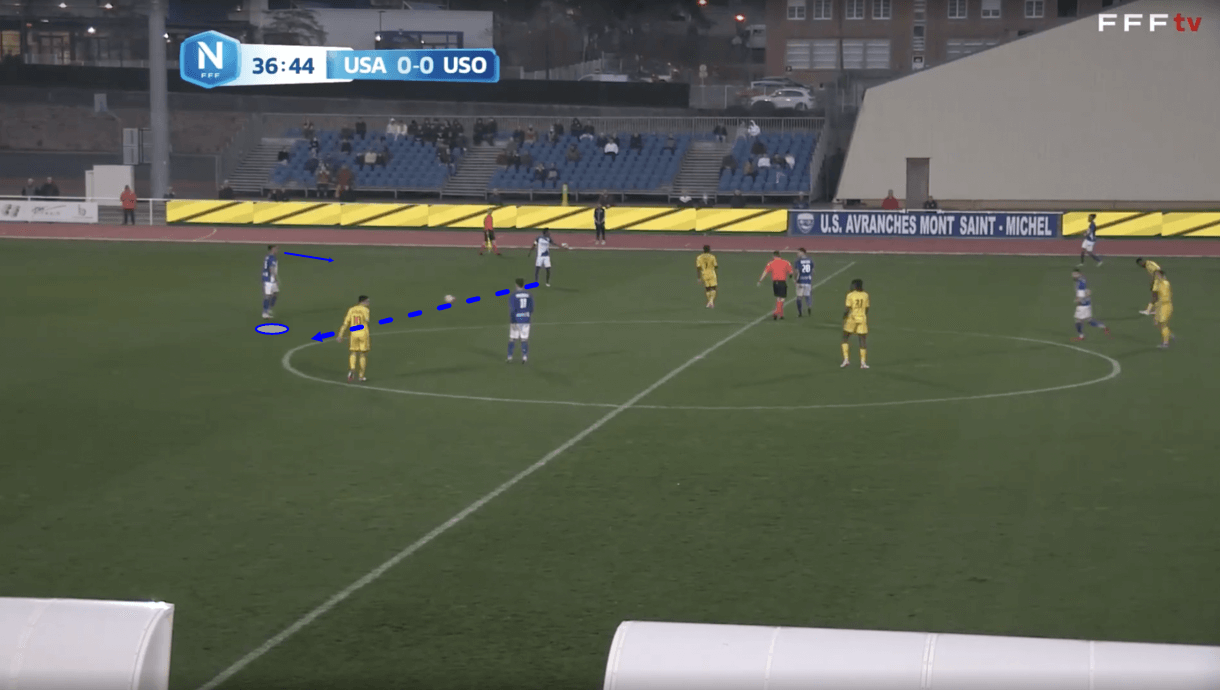
Figures 1-2 show an in-game example of the Avranches man’s ball progression quality in action. Firstly, we see Voyer receiving the ball centrally in the progression phase in figure 1. Furthermore, this image shows the centre-back scanning upfield as the ball is in transit towards him. In doing so, Voyer creates an opportunity for himself to 1. Familiarise himself better with where teammates and opposition players are positioned on the pitch ahead of him — thus aiding his decision-making process and 2. Check for any incoming pressure from opposition players to ensure he’s not caught off-guard and dispossessed in a highly-sensitive position.
Additionally, Voyer chooses a great time to scan, waiting until after the passer had released the ball to him, ensuring he didn’t miss any important actions on the ball and waiting for the ball to be moving in a linear motion which he can afford to miss, knowing how the ball is travelling.
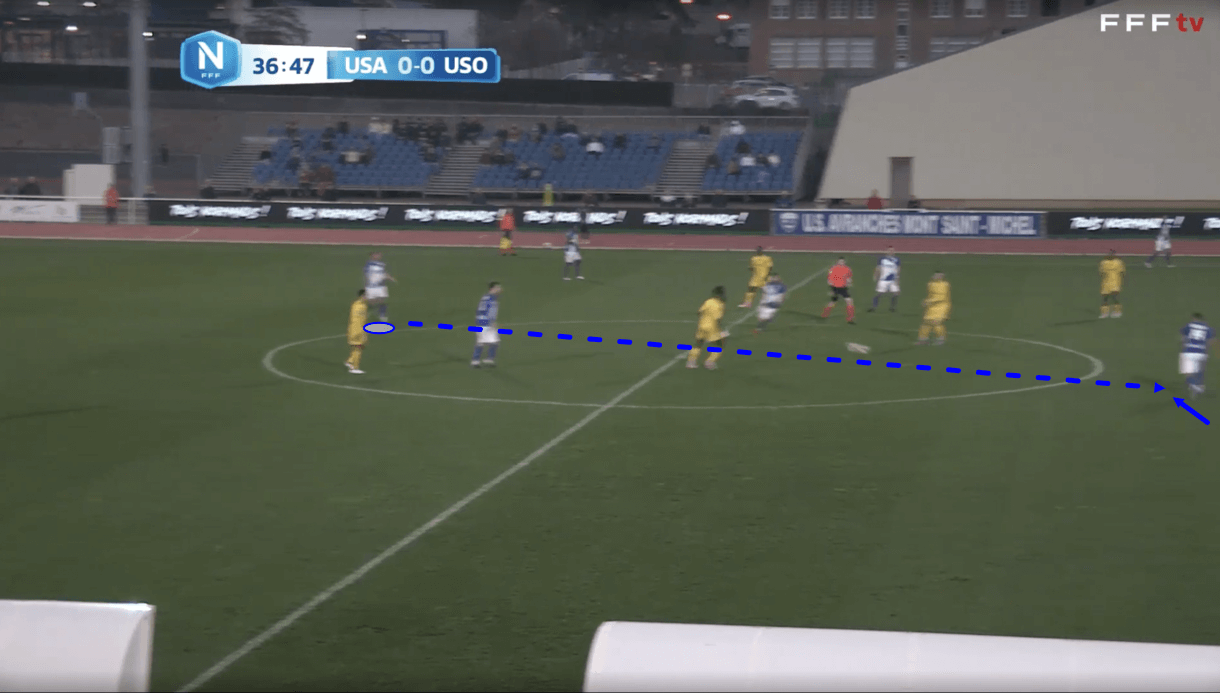
After receiving the pass, Voyer turned out towards the opposition’s half of the pitch, took a step forward and then drove the ball into midfield, bypassing the opposition’s first two lines of pressure with a picture-perfect defence-splitting progressive pass, as is depicted in figure 2. This was a risky pass in the sense that misdirecting or mispowering it even just a little bit would’ve resulted in an easy interception for the opposition but Voyer successfully split the opposition’s shape open with a crisp, accurate forward pass into the feet of his teammate who we see running into the centre to meet the ball.
This is a typical pass for the 25-year-old to be seen making. He’s very comfortable with driving the ball directly through the centre of the pitch in a vertical yet accurate fashion as we see in figure 2 and has made plenty of progressive passes in this manner in 2021/22. Again, this pass is risky in its nature but very rewarding should it come off and Voyer’s progressive passing game can be summarised by its high risk-high reward style.
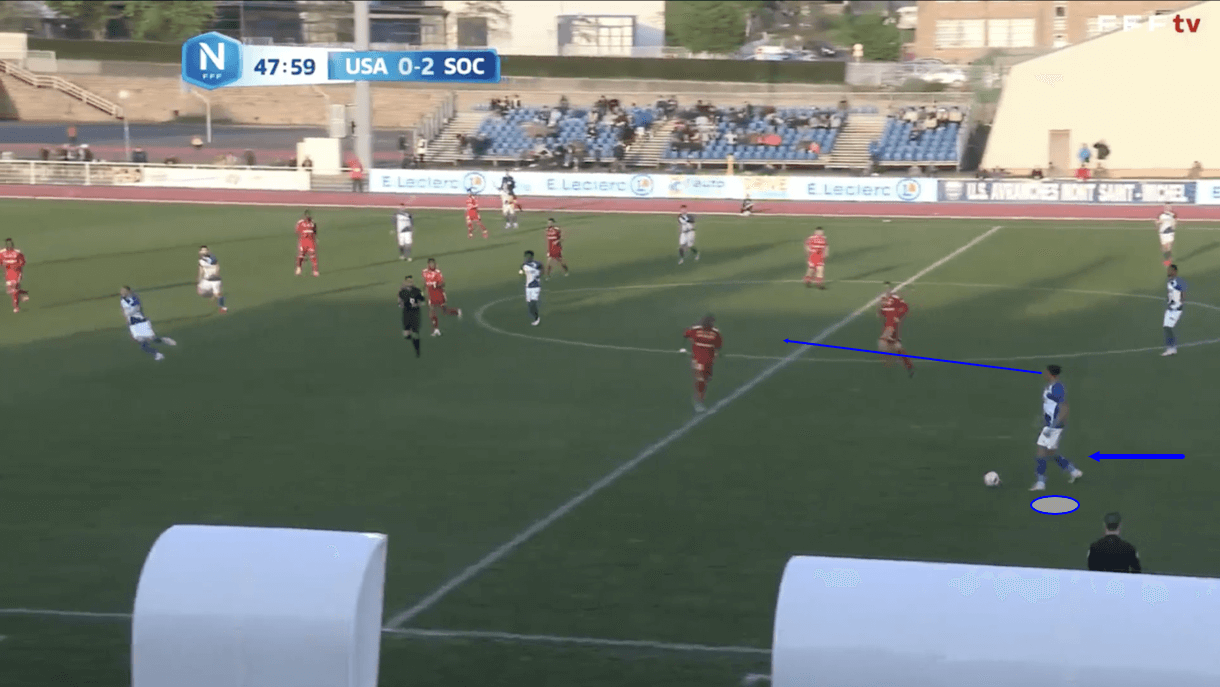
Per Wyscout, where all of the statistics included in this tactical analysis have been sourced, Voyer also plays a relatively high number of long passes (7.71 per 90) when compared with National 1’s centre-backs — again indicative of his role as a ball progressor in this team. Figures 3-4 show an example of the centre-back’s long passing ability in action. Starting with figure 3, just before this image, the 25-year-old received the ball and drove forward a few steps while observing the positioning and movement of players ahead of him. This sees Voyer end up in the position we see him in figure 3, just about to launch a long pass forward.
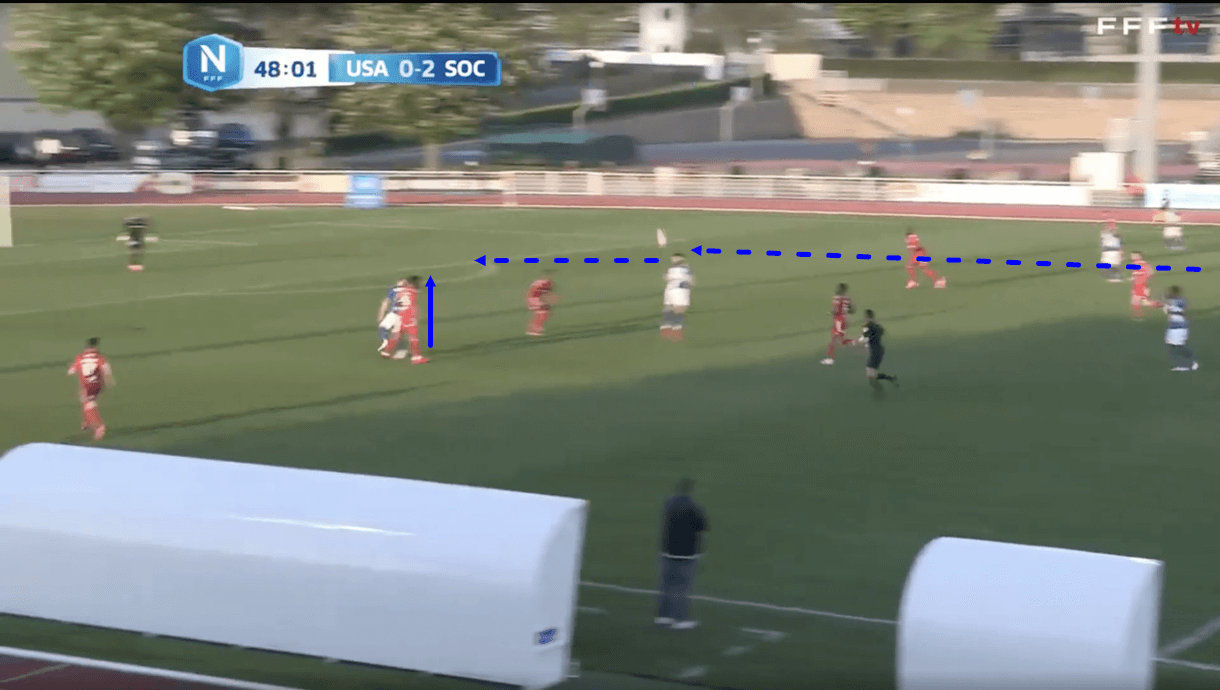
Moving on into figure 4, we see how Voyer’s long pass lands on the head of one of his team’s attackers who’s found some space in between the lines where he can get up, win the aerial ball and knock it on for a runner in behind the opposition’s backline. This sets up a great goalscoring opportunity for Avranches and highlights how Voyer’s vision and technique can be extremely beneficial for his side, with those qualities combining to help him successfully pick out this teammate dropping in between the lines on this occasion.
Indeed, Voyer has demonstrated great vision to pick out opportunities for successful long passes like this one in 2021/22 and the centre-back has the technical quality to pull off such passes too, as this example highlights. Voyer is capable of dropping a ball from deep right onto a teammate’s chest or head, as we see here, in order to advance the team into a more threatening area, and this is a very valuable quality for Avranches to possess in their team from deep.
Ball control and ability under pressure
Voyer is a creative, line-breaking centre-back in terms of his passing but he isn’t much of a ball-carrier. You won’t often find him trying to beat men via this method, instead preferring to rely on his passing when it comes to performing his role in progressing the team upfield.
As well as technique and vision, which we analysed extensively in the previous section of analysis, ball control, a good first touch and both technical and mental ability under pressure are important aspects of the Avranches man’s game worth noting. This next section of our scout report looks deeper into these particular aspects of the 25-year-old’s game, beginning with some analysis of an in-game example of the centre-back playing out of pressure in a more advanced area of the pitch in figures 5-6.
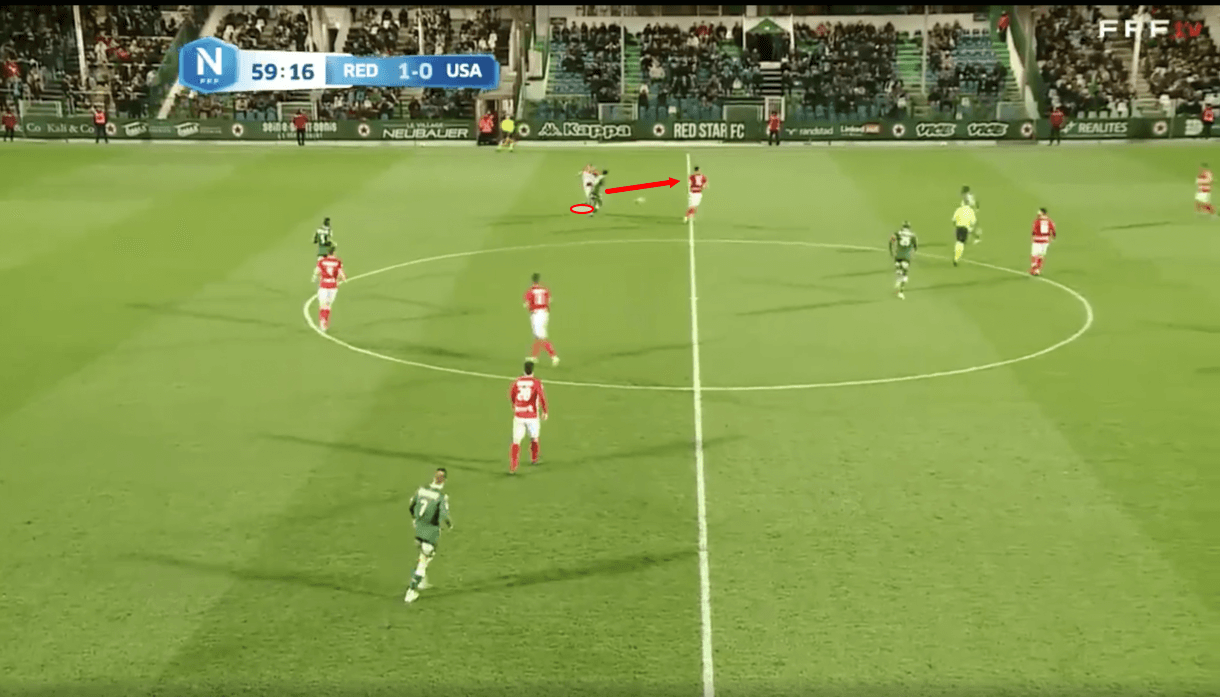
Just before figure 5, Voyer headed the ball out past the opposition forward nearest to him in the image before getting around the attacker and getting back onto the ball. This set up an opportunity for the centre-back to start driving forward with the ball, as we see in the image. In doing so, Voyer took on the burden of carrying the ball while under pressure but only for a short time in order to drive into space and set up a good, clear forward passing opportunity.
While Voyer doesn’t often look to beat pressure with his carries, he is fairly comfortable attracting pressure to himself, demonstrating great confidence in his ability to retain possession despite coming under pressure. Balance and agility are important technical attributes for the centre-back to possess in a situation like this, which he does possess in decent enough quantities.
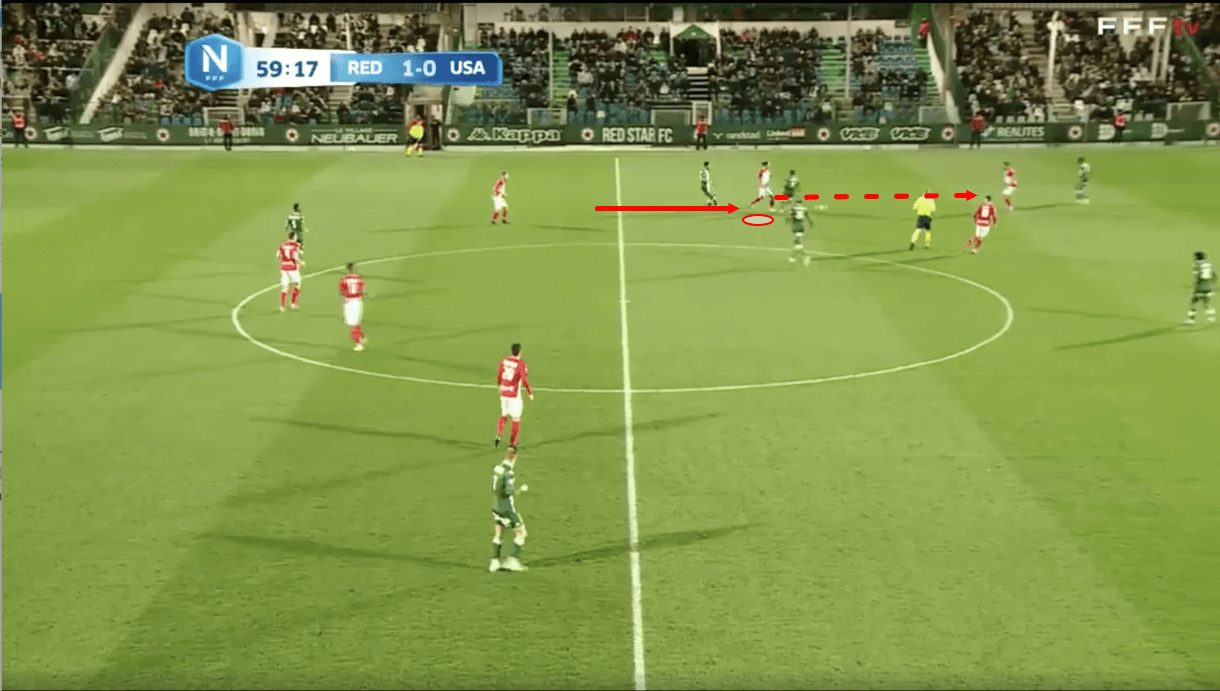
As we move on into figure 6, we can see how Voyer succeeded in getting past the opposition forward who was pressing him, moving up into a decent forward passing position and releasing — again breaking lines by driving the ball past the onrushing midfielder and into the feet of an attacker with his back to goal further up in the middle third of the pitch. The receiver immediately attracts attention from another opposition defender — who we see just behind them in this image — while another Avranches attacker drives forward in support.
So, we see how Voyer’s efforts in beating the pressing forward, moving into a safe and valuable forward passing position and picking out the teammate in a more valuable and more threatening position just ahead were key for his team’s attack on this occasion, and we’ve seen Avranches enjoying the advantages of Voyer’s ball progressing abilities in plenty of similar situations to this one in the 2021/22 campaign. On this occasion, the centre-back’s ball control and other aforementioned qualities relevant to his ability under pressure were more evident than his technical passing quality and vision, showing how those qualities also combine with his all-around game to make him a well-rounded asset in ball progression.
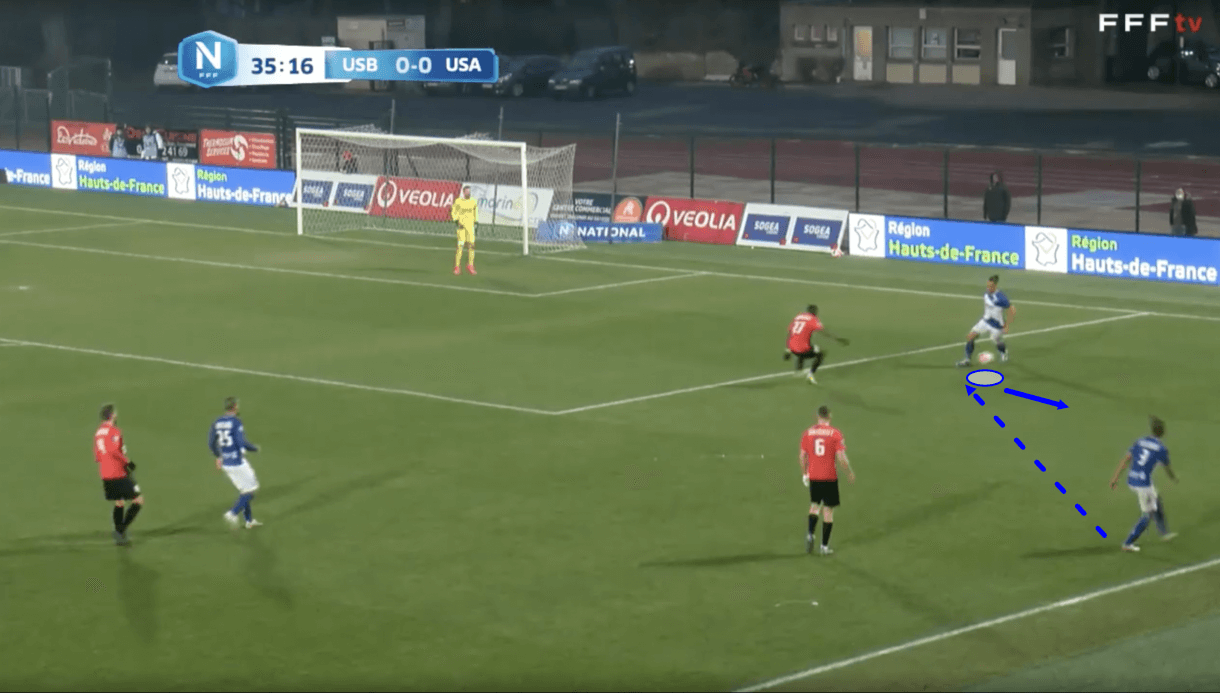
The PSG academy product generally takes a good first touch. I sometimes feel like he could play with a bit more intensity and a bit more urgency to his game, which is probably a symptom of the fact that, solely looking at his quality on the ball, National 1 is below his level and he’s capable of operating at less than 100% intensity while still getting the job done to a reasonable extent. This is true for his first touch, as well as other areas of his game but the centre-back generally opens up his body to receive well and constantly performs diligent, effective scanning to help his decision-making and ensure his intended first touch isn’t accidentally a dangerous one. However, still, he rarely takes a particularly bad first touch and usually does a good job of setting himself up to continue his team’s move and progress them further upfield.
Figures 7-8 will show just one example of Voyer’s first touch and I intend to show not just his technical proficiency in this area via this in-game example but also his mentality in terms of how he protects the ball from the pressing player while still setting up an opportunity to progress the team upfield. In figure 7, we see Voyer has just received a pass from the left-back and has immediately come under pressure from an opposition forward. The centre-back deals with this pressure via his first touch, which takes the ball away from the side nearest to the pressing forward and onto his stronger left foot.
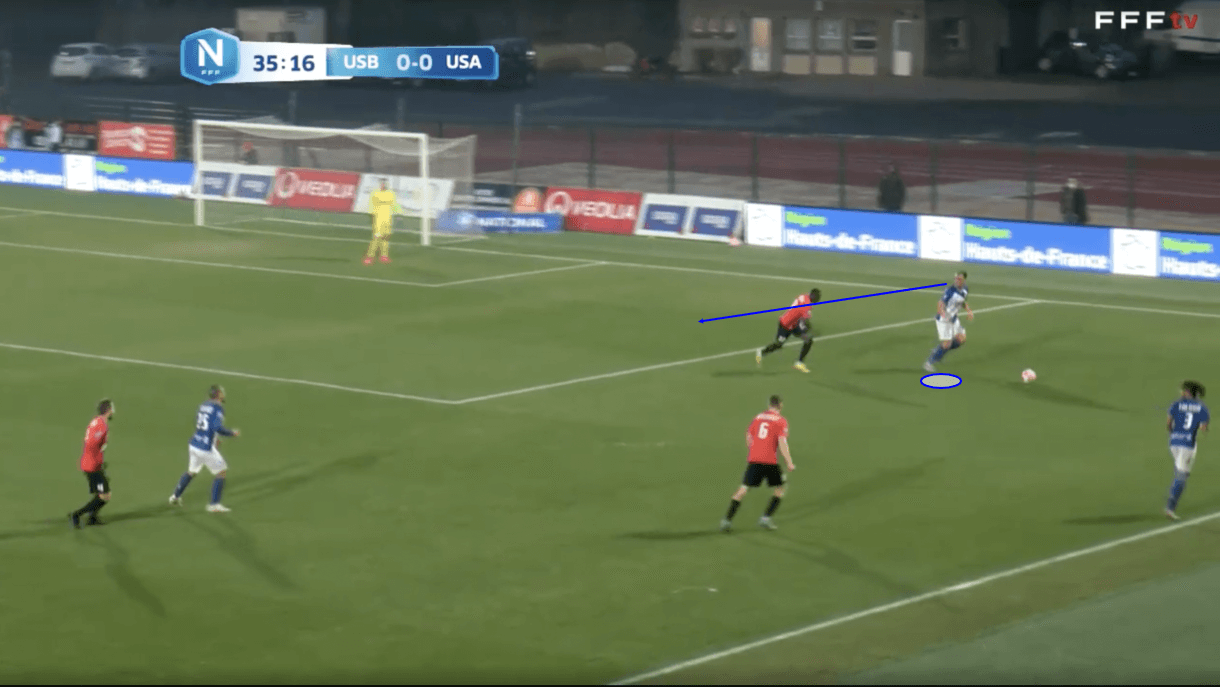
As we progress from that into figure 8, we see how now, with the ball on his stronger side as well as the side further away from the pressing forward, Voyer has placed his body between the attacker and the ball, providing further security to his team’s period of possession, as now the attacker would have to go through Voyer to get to the ball — and successfully achieving this without giving away a free kick to Avranches would be very difficult, far more difficult than just stealing the ball from the 25-year-old had he kept it on the right side with his first touch rather than moving it away from the defender and taking the precautions we see.
Voyer bought himself some time to scan for movement ahead of him before launching the ball upfield, into a teammate’s running path; the fact he was able to not just get the ball out of the danger zone but actually retain possession while under pressure and in a difficult position here highlights Voyer’s calmness and technical quality under pressure. The mental ability to quickly process the incoming pressure and decide on how to take his first touch and also put his body between the defender and the ball as an extra layer of protection is highly impressive and we see the centre-back demonstrating these skills a lot for Avranches, again highlighting how his ability on the ball may be a level above National 1.
Yes, Voyer is sometimes slightly casual in possession and he is undoubtedly a big risk-taker but for the level, he does more than enough on the ball to be seen as one of if not the most valuable ball-playing centre-back in the league, which will make him an attractive prospect for clubs at Ligue 2 level heading into the summer transfer window.
Aggressive defending — a potential issue?
In his recent interview with Le Titis du PSG, Voyer explained: “I am much more aggressive in duels than when I played at Paris Saint-Germain. I communicate more and am less nonchalant than before. I’m more awake, it will make some of my former coaches laugh!”
However, Voyer has engaged in a relatively average number of defensive duels for a National 1 centre-back in 2021/22 (6.11 per 90), indicating that he still shouldn’t necessarily be regarded as an ‘aggressive’ centre-back. That’s not necessarily a negative — he doesn’t have to be an aggressive centre-back to be an effective centre-back; a passive centre-back can also be a huge asset and often, a combination of aggressive/passive is optimal.
However, the big area of concern with regard to Voyer’s defensive duels, for me, is his success rate when he does engage aggressively. It’s clear that this is an area in which the Avranches man is still growing so I don’t point this out for the sake of assassinating the player, rather I feel it’s important to highlight that this remains a big area of potential improvement within his game. Perhaps over time, as he gets more and more comfortable defending aggressively, with the 25-year-old having recently indicated that this isn’t an area in which he’s particularly comfortable, his success rate will improve too — I’d imagine this will be the case — however, at present, I feel Voyer isn’t comfortable defending aggressively nor is he particularly effective at it, which his relatively low 60.13% success rate would also suggest.
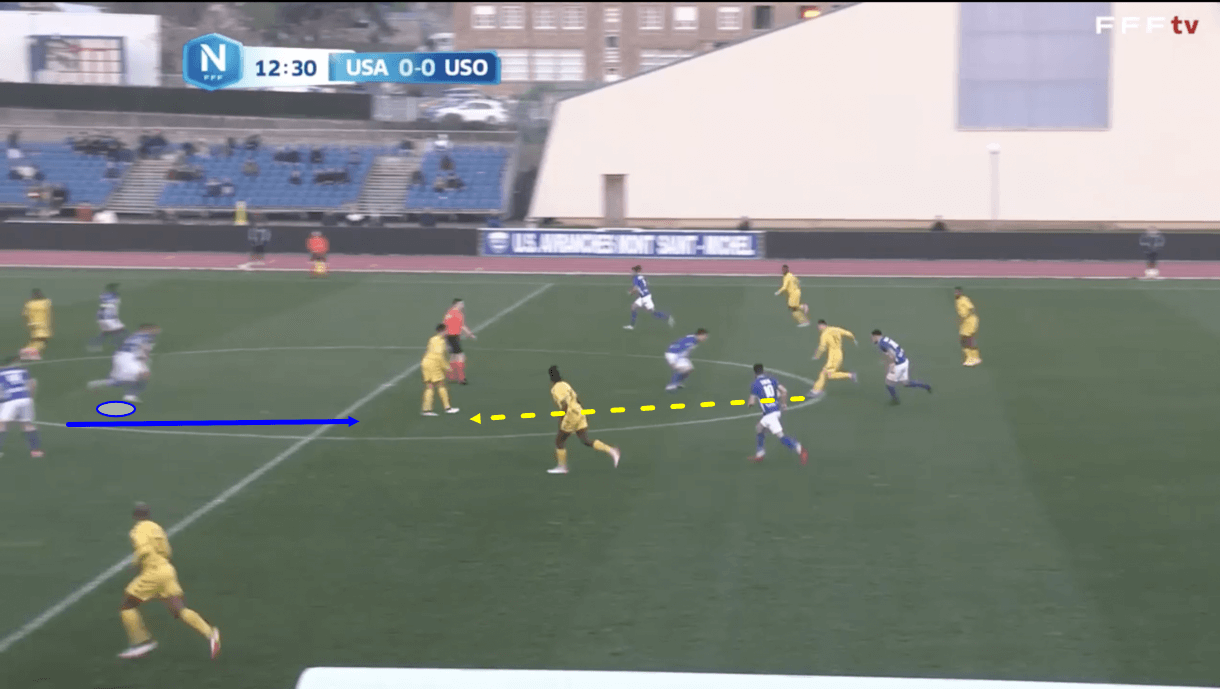
We see an example of Voyer getting dragged out of defence and into a defensive duel in figure 9. The defender jumps early, noticing the danger of the opposition attacker receiving between the lines, and aims to prevent the attacker in space who’s likely to receive the ball from turning and running at the defence. In terms of his thinking and timing of when to jump, I don’t really think Voyer does much wrong here, although he’d benefit a lot from not having to act aggressively by being protected with a more compact midfield line. Nevertheless, this was the problem presented to him and this was the solution he opted for — not a particularly bad one and the defender should be able to get right on the attacker’s back and prevent him from doing further damage.
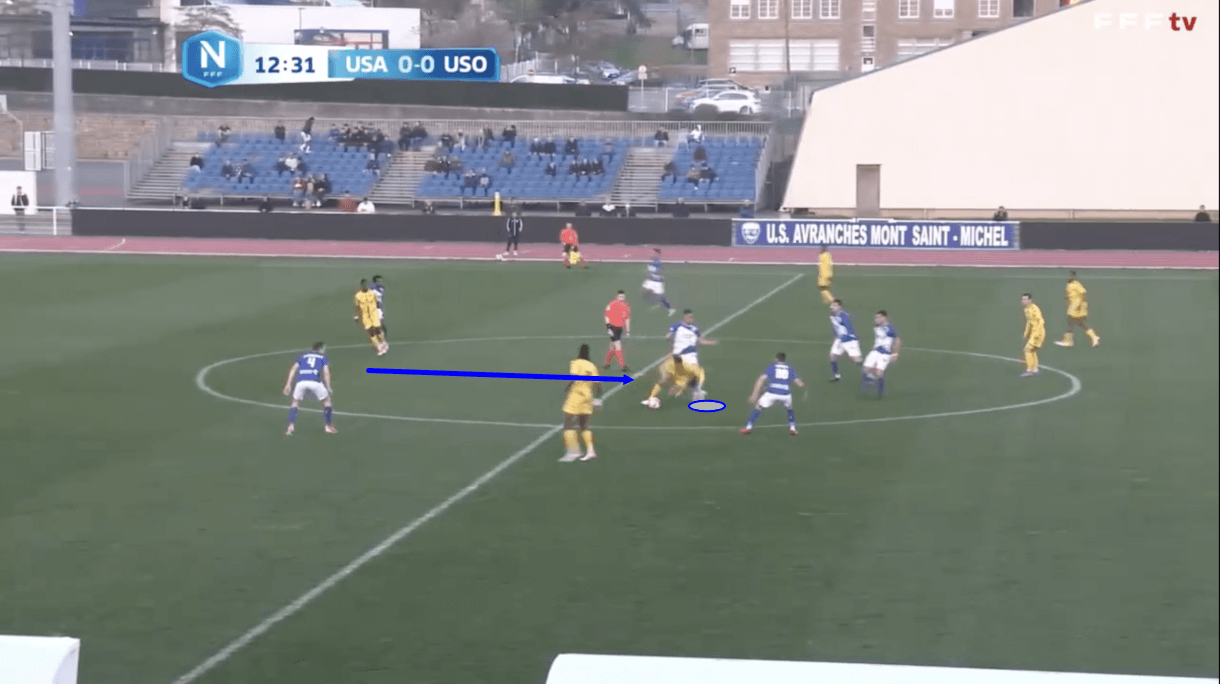
As play progresses into figure 10, however, we see that the timing of Voyer’s challenge is wrong. Rather than standing the attacker up and waiting for reinforcements to create a heavily advantageous defensive duel for Avranches, Voyer goes straight in for the challenge and the attacker manages to turn him, winning a free kick for his side.
For me, the 25-year-old’s big problem in aggressive defensive duels is the timing of his challenges. Yes, he needs to be aggressive in knowing when to go and when not to go — decide early, don’t get caught in between two minds. The old saying of: ‘you can’t be half pregnant’ comes to mind here. There’s no need to be overly aggressive in committing to the challenge, however, which Voyer was here. So if the defender can work on the timing of his challenges and being more patient once he arrives at the man, I’d imagine his defensive duel success will improve and this aspect of his game will become a far greater asset for his side.
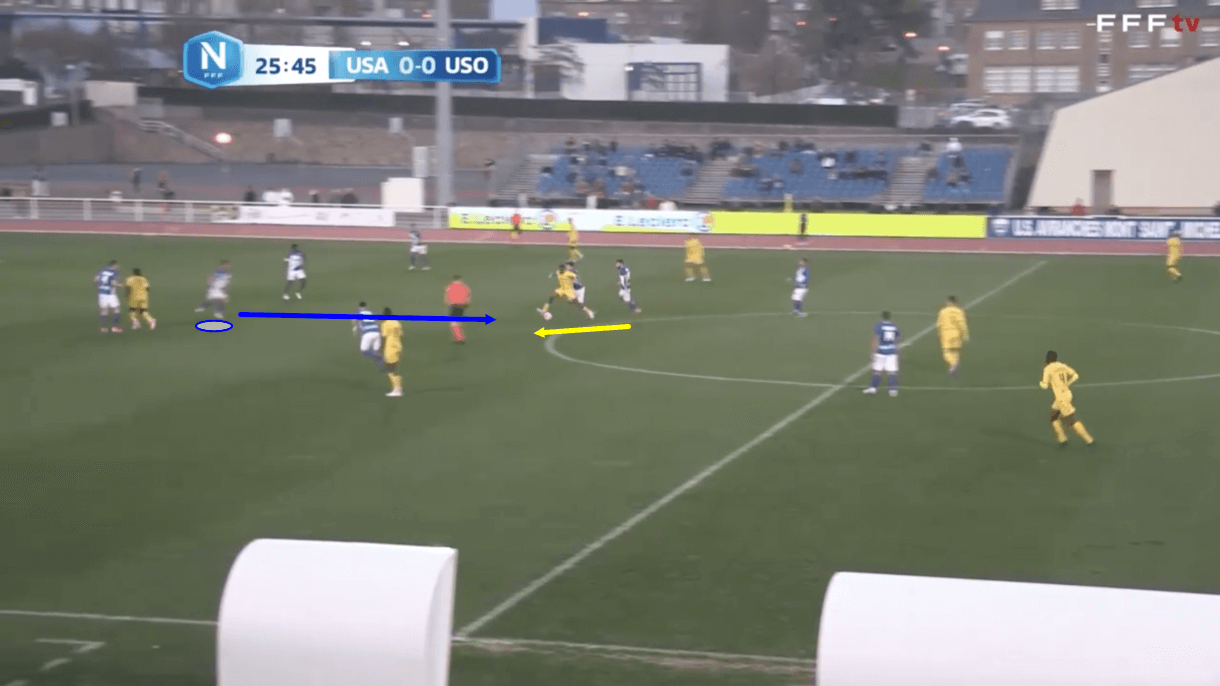
Figure 11 shows a similar example of the defender getting dragged out from the back, this time, though, the player who’s received in between the lines is already facing Avranches’ goal by the time Voyer starts to make his move. This is a far less favourable situation for Avranches than the previous occasion when the defender jumped from the backline because the attacker who’s received has already turned so once Voyer reaches him, the momentum will favour the attacker and if the defender gets beaten, which there’s a good chance of, then he’ll struggle to recover.
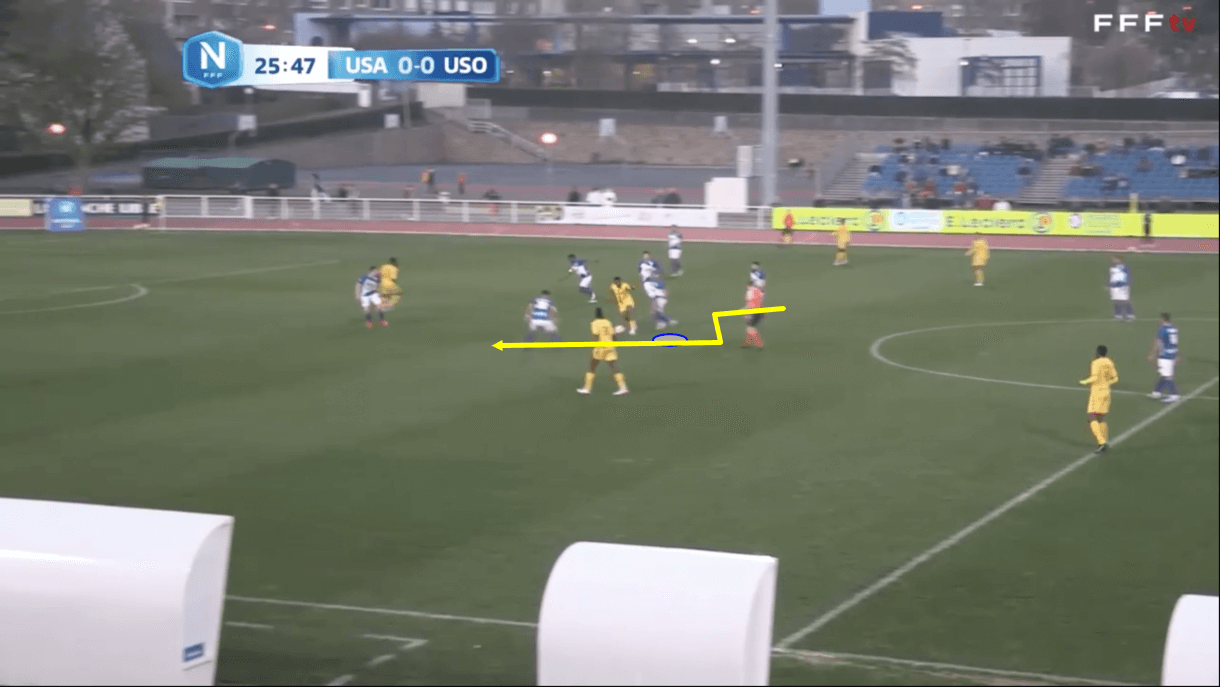
Again, the timing of Voyer’s challenge is poor and the attacker does manage to get past the 25-year-old centre-back and progress further into Avranches’ half, as we see in figure 12. Here, Voyer was, perhaps, too hasty to jump when the attacker was already dribbling towards Avranches’ goal and again, his challenge itself was mistimed and it ultimately failed to help his side stop the attack/regain possession. As previously mentioned, from this point, it would be difficult for the centre-back to recover given that the attacker has progressed past him while facing the direction he’s moving, while Voyer needs to stop and turn to get back.
So here again we see some major issues with Voyer’s defensive timing which cost his side in a sensitive situation. If the 25-year-old can improve on these issues, he’ll be a far greater defensive asset but I just believe he’s clearly not comfortable operating as an aggressive centre-back and doesn’t perform well in such a role, so maybe he shouldn’t try to become one. Instead, perhaps focus on being the best ‘passive’ centre-back he can be and pair him with one (or perhaps two, as I’d suggest) more aggressive defenders, allowing Voyer to sweep up behind.
Reading the game
Voyer isn’t a naturally aggressive centre-back — he is a natural sweeper. I’d recommend playing into that, not trying to mould him into something that at 25, he may never be incredible at. While Voyer doesn’t engage in many defensive duels and has an even less impressive defensive duel success rate, he still ranks highly among National 1 centre-backs for successful defensive actions (11.95 per 90). This can mainly be attributed to his excellent defensive positioning and ability to read the game — skills that have helped the Parisian defender to impressively make the most interceptions (7.59 per 90) of any National 1 centre-back in 2021/22.
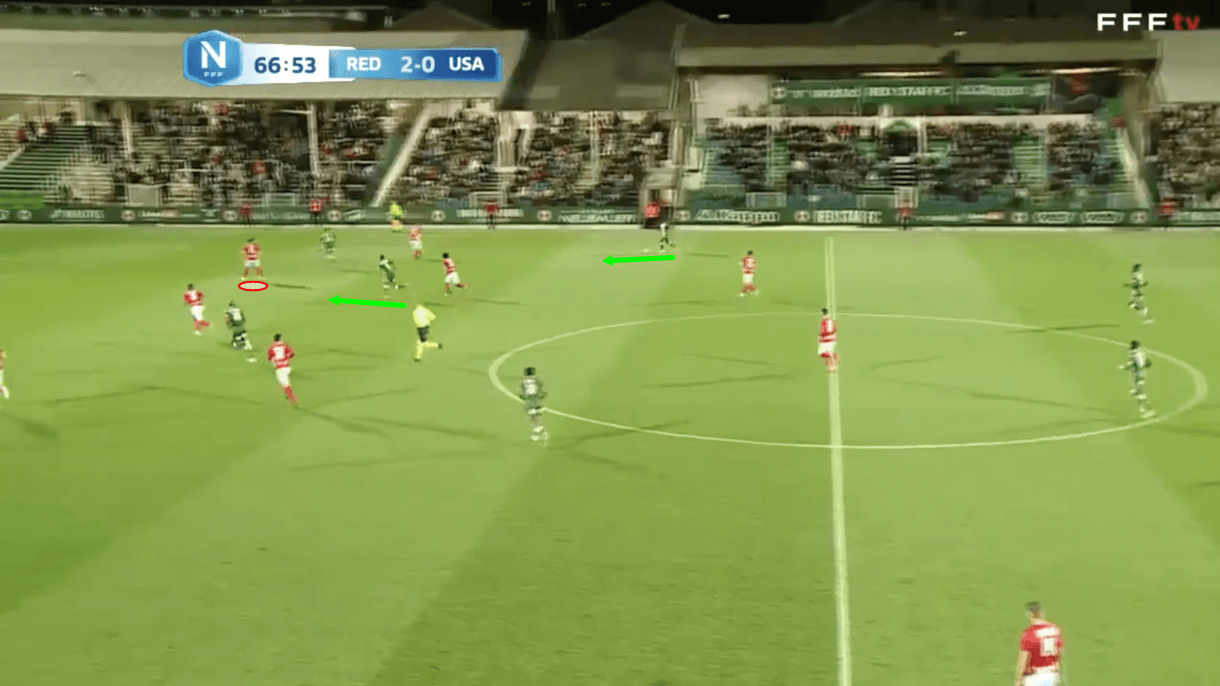
Figures 13-14 showcase the 25-year-old’s reading of the game, anticipation and overall impressive interception-making ability. Firstly, in figure 13, we see the opposition, Red Star from Voyer’s home city of Paris, on the attack having just broken into Avranches’ half of the pitch. The ball-carrier has his head up while dribbling forward which helps him to spot a probing run from a teammate positioned closely to Voyer though slightly deeper at this moment, aiming to attack space between Voyer and his central defensive partner. At the same time as the attacker is making this run, the Red Star attacker on the other side of Voyer and slightly higher up is running towards the wing, behind Avranches’ full-back, which threatened to drag the 25-year-old centre-back away from the centre and out to the wing, a move that would theoretically free up more space for the runner to exploit.
Note Voyer’s body position here: he’s positioned himself well enough to see the dribbler and have a peripheral view of the runners on either side which helps him to remain aware of all danger threatening his particular zone at this moment. This body positioning is crucial in helping the centre-back to successfully end this attack, as we see when moving on into figure 14.
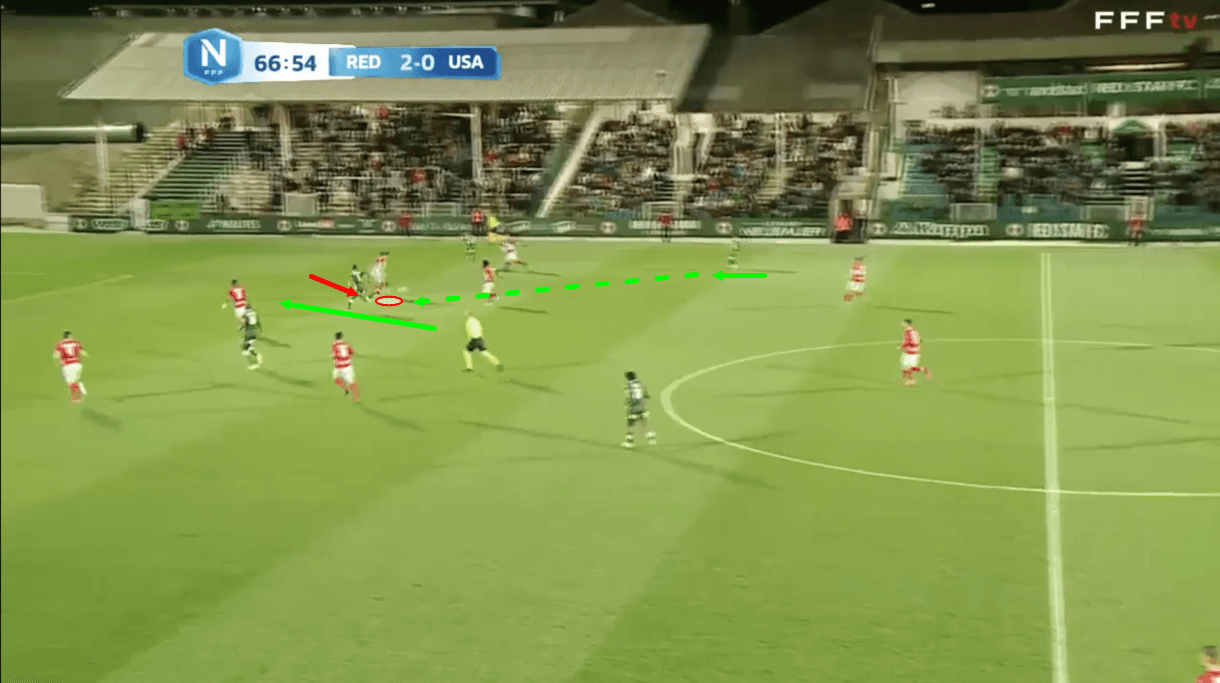
The ball was played into the path of this runner targeting space between the Avranches centre-backs but the wily Voyer had been keeping an eye on this potential move from Red Star. As a result, when the pass was played, the centre-back — again aided by his fairly open body position — was able to jump out into the passing lane and cut out the through ball, preventing this potentially dangerous final third entry and regaining possession for Avranches — kickstarting a counter-attack.
Interceptions can often kickstart counter-attacks in this fashion while significantly turning momentum against the team that’s just lost the ball. Voyer’s ability to pull off interceptions along with his playmaking ability make him a great asset in transition to attack in this way, as well as just being a solid defensive outlet when it comes to reading the game, anticipating passes and cutting them out.
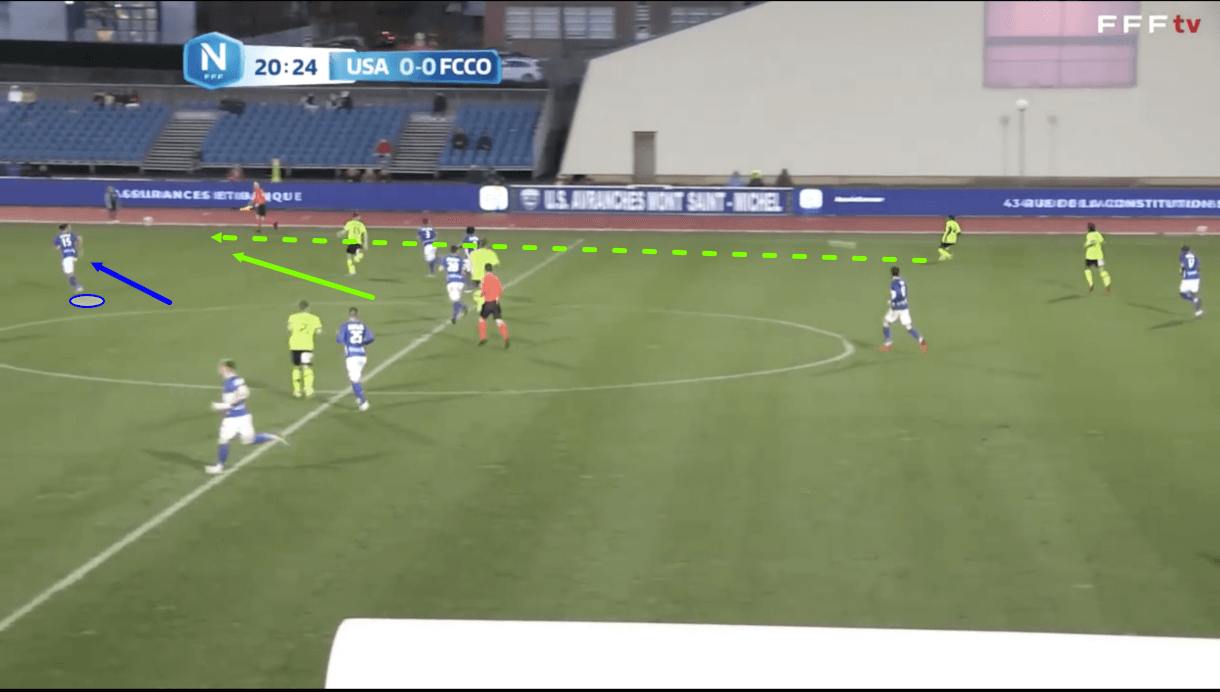
On top of this, Voyer is very comfortable being responsible for the space behind the backline. He possesses good-not-great pace and, again, excellent anticipation skills that make him an asset for sweeping up behind the backline. We see one example of this in figures 15-16. Firstly, in figure 15, we see the opposition sending a through ball to a runner attacking space behind the full-back on the wing. Here, we see how these runs from in to out, like the one the attacker on the defender’s left made in the previous passage of play, can be a direct threat in and of themselves — making them effective dummy runs as they can be effective directly should the ball get played through to them.
Voyer gives himself a lot of ground on the attacker and begins his backwards run as soon as the pass is played, helping his chances of getting there before the runner. It’s very common to see Voyer operate like this to the extent that sometimes, I think he goes too early and would be better off, again, biding his time a bit more especially given that he’s not that slow. However, the issue isn’t as big as when he’s jumping forward to defend space in front of him even if it is still an area of potential improvement.
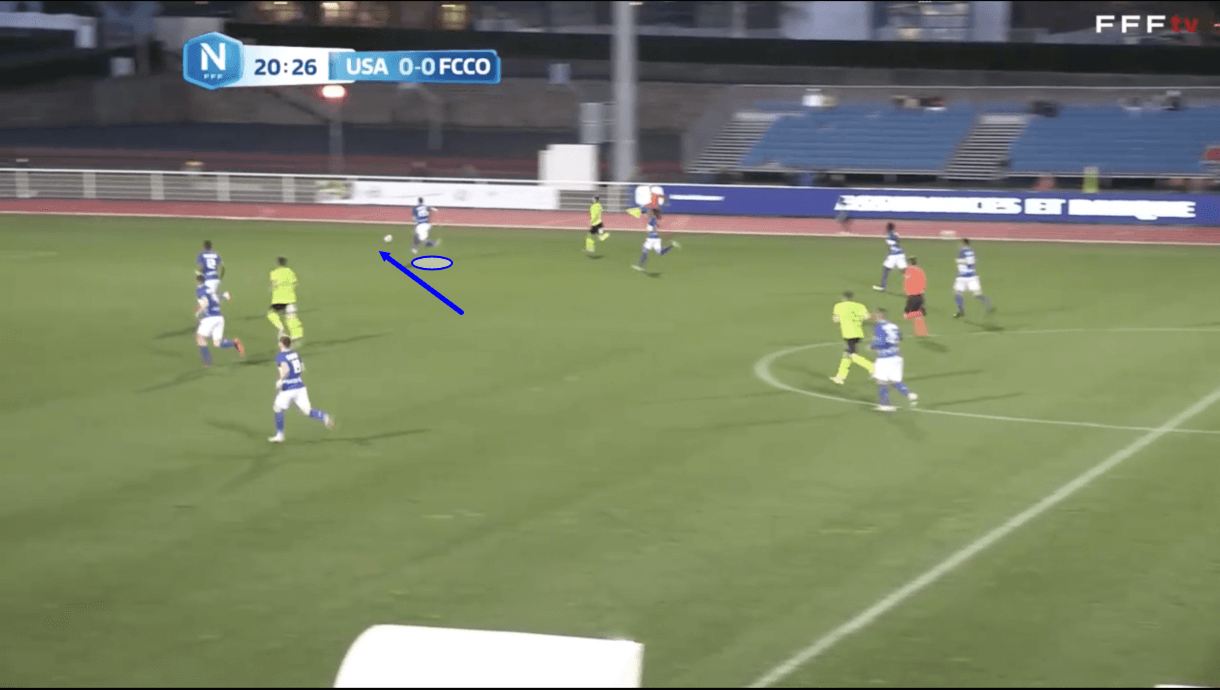
Voyer successfully gets to the ball ahead of the attacker, setting up a situation where he has his back to where he wants to go and has a runner right on his back. However, as mentioned earlier, the centre-back is very comfortable under pressure and can play out of such situations effectively so if you do need to end up with someone in this scenario, you’d probably be happy enough, if you’re Reculeau, for it to be Voyer.
Conclusion
To conclude this tactical analysis and scout report, it’s clear that Voyer is a terrific asset for his team on the ball and should be used as a key part of his team’s setup in the build-up/ball progression phases of play. His passing quality combined with his vision and comfortability under pressure combine to make him elite in this area at National 1 level.
Defensively, Voyer needs more protection than he’s been offered at Avranches this term if you’re going to get the best out of him. In particular, I’d like to see the defender focus less on improving his game as an aggressive defender and focus more on nailing his role as a more passive defender. I’d be interested in seeing Voyer used as a central centre-back in a three-centre-back defence, given licence to not worry too much about defending the space in front of him and allowed to focus on sweeping up behind and defending this space. I think the protection of two central defensive partners on either side along with more midfield protection than he’s had this season would alleviate the pressure on Voyer’s defensive game while highlighting where he excels off the ball, while still availing of his obvious on-the-ball qualities.
On that basis, or a different set of conditions that a coach feels highlights the aforementioned strengths while hiding the aforementioned weaknesses, I feel Voyer is ready for a step up to Ligue 2 but I couldn’t advocate for that in the same system he’s played this term solely based on his defensive frailties.





Comments